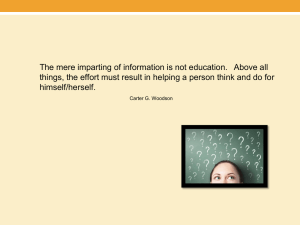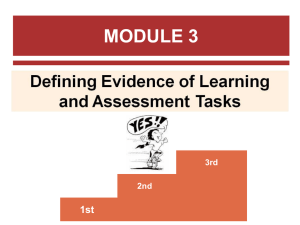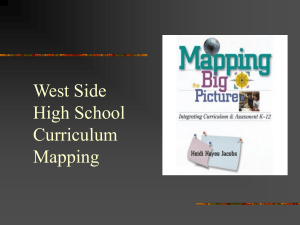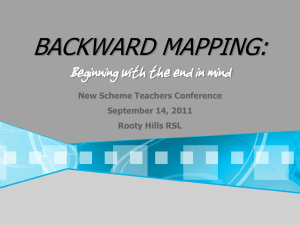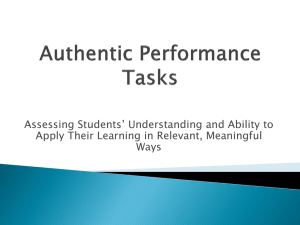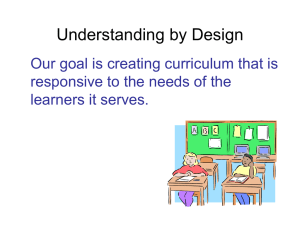Planning a Problem-Based Lesson (Powerpoint file)
advertisement
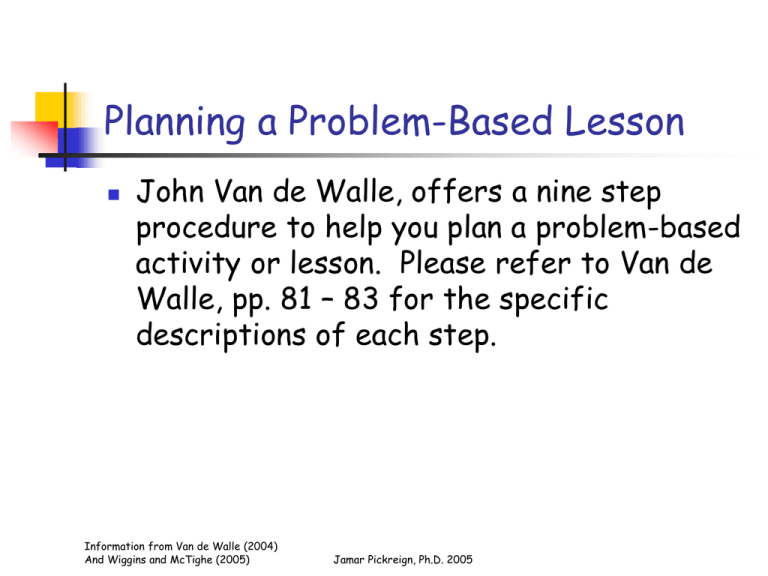
Planning a Problem-Based Lesson John Van de Walle, offers a nine step procedure to help you plan a problem-based activity or lesson. Please refer to Van de Walle, pp. 81 – 83 for the specific descriptions of each step. Information from Van de Walle (2004) And Wiggins and McTighe (2005) Jamar Pickreign, Ph.D. 2005 Planning a Problem-Based Lesson Begin with the Math! This might be what Wiggins and McTighe (2005) refer to as desired results Much of this will be based on what you know about the learners (appropriate assessments) and what you know they are expected to learn (curriculum, standards), so… Information from Van de Walle (2004) And Wiggins and McTighe (2005) Jamar Pickreign, Ph.D. 2005 Planning a Problem-Based Lesson Think about your students Wiggins and McTighe might recognize this in their idea of Tailoring to student needs, interests, and styles Information from Van de Walle (2004) And Wiggins and McTighe (2005) Jamar Pickreign, Ph.D. 2005 Planning a Problem-Based Lesson Decide on a Task This is related to Wiggins' and McTighe's Stage 2 in which we are encouraged to think about what evidence for the desired result looks like, and what would be appropriate evidence for desired understandings This decision will also be based on your knowledge of content and your "research based repertoire of learning and teaching strategies." Information from Van de Walle (2004) And Wiggins and McTighe (2005) Jamar Pickreign, Ph.D. 2005 Planning a Problem-Based Lesson Predict What Will Happen This is where you get to "play it out in your head." Based on what you know about learners, teaching, and content, think about what learners might do with a task. Think about what knowledge/skills/dispositions they must have to engage in the task. Consider whether it is a Worthwhile Mathematical Task (NCTM 1991) Information from Van de Walle (2004) And Wiggins and McTighe (2005) Jamar Pickreign, Ph.D. 2005 Planning a Problem-Based Lesson Articulate Student Responsibilities This is where you consider such things as some of Wiggins' and McTighe's WHERETO elements Where is it going Hook the students Explore and equip Rethink and revise Exhibit and evaluate Tailor to needs, interests, and style Organize for maximum engagement and effectiveness Information from Van de Walle (2004) And Wiggins and McTighe (2005) Jamar Pickreign, Ph.D. 2005 Planning a Problem-Based Lesson Plan the BEFORE portion of the lesson In Wiggins' and McTighe's WHERETO elements, this is Where is it going Hook the students Explore and equip Rethink and revise Exhibit and evaluate Tailor to needs, interests, and style Organize for maximum engagement and effectiveness Information from Van de Walle (2004) And Wiggins and McTighe (2005) Jamar Pickreign, Ph.D. 2005 Planning a Problem-Based Lesson Think about the DURING portion of the lesson In Wiggins' and McTighe's WHERETO elements, this is Where is it going Hook the students Explore and equip Rethink and revise Exhibit and evaluate Tailor to needs, interests, and style Organize for maximum engagement and effectiveness Information from Van de Walle (2004) And Wiggins and McTighe (2005) Jamar Pickreign, Ph.D. 2005 Planning a Problem-Based Lesson Think about the AFTER portion of the lesson In Wiggins' and McTighe's WHERETO elements, this is Where is it going Hook the students Explore and equip Rethink and revise Exhibit and evaluate Tailor to needs, interests, and style Organize for maximum engagement and effectiveness Information from Van de Walle (2004) And Wiggins and McTighe (2005) Jamar Pickreign, Ph.D. 2005 Planning a Problem-Based Lesson Write your lesson plan Find a format in which you can articulate the previous 8 steps. One such example is in your field guide Another example is from Wiggins' and McTighe's (2005) Understanding by Design Still another is from your student teaching handbook Information from Van de Walle (2004) And Wiggins and McTighe (2005) Jamar Pickreign, Ph.D. 2005 Planning a Problem-Based Lesson The point is any format that allows articulation of these elements is a 'good' one "To use an analogy with storytelling, a story needs a plot, characters, and a setting. Those are story elements, just as WHERETO [and the 8 steps here] summarizes the design elements. But how should those elements be fashioned into the most engaging and effective whole? There are many possible beginnings, middles, and ends. Just as a storyteller might begin with fragments of dialogue or a description of a character and work toward a plot (or vice versa), design work, too, can emerge over time, following many different paths and sequences" (Wiggins and McTighe, 2005, p. 198). Information from Van de Walle (2004) And Wiggins and McTighe (2005) Jamar Pickreign, Ph.D. 2005

